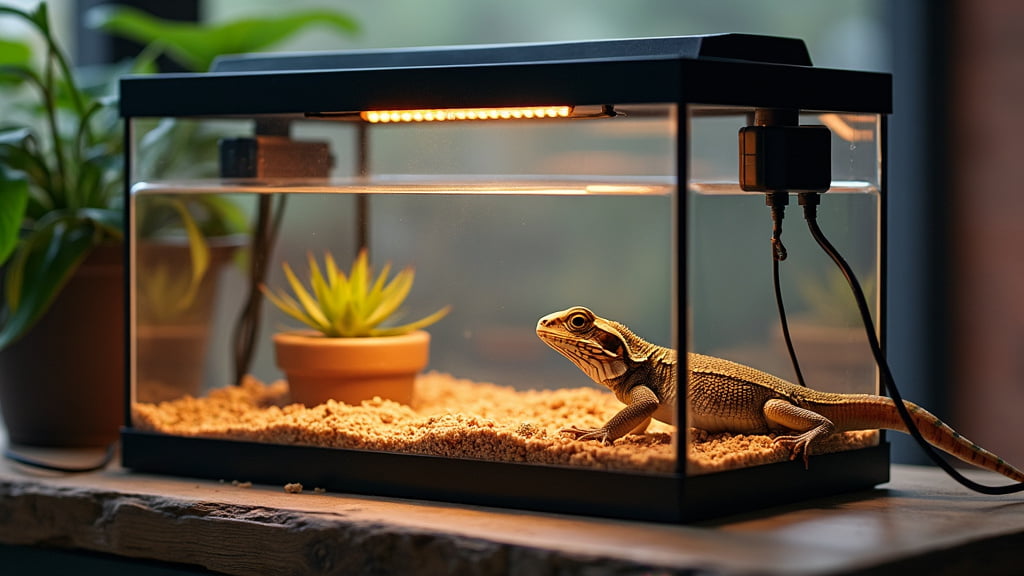Heating Setup for Bearded Dragon Tanks
Introduction
When it comes to the well-being of your bearded dragon, one of the most pivotal aspects is the heating setup in its tank. A properly configured heating system is critical to mimic the sun-baked Australian habitats where these fascinating reptiles originate. Today, I’ll guide you through the ins and outs of creating an optimal heating environment for your bearded dragon’s tank, sharing personal insights and practical advice from years of experience.
Remember, temperature regulation isn’t just about comfort—it’s a matter of health and well-being for your pet. So, let’s dive into the essentials of getting your heating setup just right.
Why Proper Heating is Essential
Heating is not merely a luxury for bearded dragons; it’s a fundamental necessity. Understanding why proper heating is crucial can help you perfect your setup.
Thermoregulation
Bearded dragons are ectothermic, meaning they rely on external heat sources to regulate their body temperature. Without the correct temperatures, they can’t digest food properly or maintain overall vitality. A well-heated environment allows for proper thermoregulation, enabling your bearded dragon to thrive.
Health Implications
Incorrect temperatures can lead to numerous health issues, such as metabolic bone disease, poor digestion, and respiratory problems. Thus, a controlled thermal gradient in the tank can help prevent these conditions and promote optimal health.
Choosing the Right Heating Equipment
Deciding on the right heating equipment can be overwhelming, given the myriad options available. Here, I’ll break down the essentials to guide you in making an informed choice.
Basking Lamp
A basking lamp is a primary heat source, mimicking the natural sunlight. Place this on one side of the tank to create a warm basking area where your bearded dragon can elevate its body temperature.
- Bulb Types: There are halogen, mercury vapour, and incandescent bulbs. Halogen and mercury vapour bulbs tend to produce UVB as well as heat, which can be beneficial.
- Wattage: The wattage depends on the tank size. For a 40-gallon tank, a 75W to 100W bulb is usually adequate.
Ceramic Heat Emitters
Ideal for maintaining warmer temperatures during the night without emitting light, ceramic heat emitters are a favoured choice to ensure consistent warmth.
- Placement: Install these in a ceramic socket fixture, ensuring they’re secure to prevent any accidents.
- Longevity: They generally have a long lifespan, making them a cost-effective option.
Under-Tank Heaters
While not the primary heating source, under-tank heaters can supplement the overall temperature, especially in larger tanks where maintaining consistent heat can be a challenge.
- Usage: Place these under one side of the tank to prevent any risk of burns.
- Thermostat: Always use a thermostat with under-tank heaters to avoid overheating.
Setting Up the Perfect Thermal Gradient
Creating a thermal gradient is pivotal in allowing your bearded dragon to self-regulate its body temperature by moving between warm and cool areas.
Basking Zone
Set up the basking zone with the basking lamp. Aim for a temperature range of 38-42°C (100-107°F) directly under the lamp.
- Basking Spot: Use rocks or branches that your bearded dragon can climb on to get closer to the heat source.
- Heat Regulation: Ensure that the basking spot doesn’t get excessively hot; a temperature gun or digital probe thermometer is handy for this.
Cool Zone
The cool zone should be on the opposite side of the tank, with temperatures around 22-27°C (72-80°F).
- Shady Areas: Provide hiding spots and shaded areas to allow for cooler temperatures.
- Thermal Stability: Maintain this area free from any direct heat sources to preserve the gradient.
Night-Time Temperatures
At night, temperatures can drop slightly but should not fall below 18°C (65°F).
- Ceramic Heat Emitters: Use these to keep temperatures stable during cooler nights.
- Monitoring: Regularly check night temperatures to ensure a comfortable environment for your dragon.
Monitoring and Adjusting Temperatures
Consistent temperature monitoring is crucial to maintaining the optimum environment. Here are some tools and tips to streamline this process:
Thermometers
- Digital Probes:Place these at various points (basking spot, ambient, cool zone) for precise readings.
- Infrared Thermometers: Useful for quick spot-checks, ensuring every area stays within designated ranges.
Thermostats
- Precision Control: Use thermostats to regulate heat sources, particularly with under-tank heaters and ceramic emitters.
- Safety Measures: Set maximum temperature limits to prevent overheating.
Conclusion
Creating the perfect heating setup for your bearded dragon’s tank is a blend of science, art, and care. By understanding the importance of proper heating, choosing the right equipment, and diligently maintaining the thermal gradient, you can ensure your bearded dragon lives a healthy, happy life. Remember, while this guide provides a solid foundation, always consult with a reptile vet for specific health concerns or advanced setup questions.
For further reading on bearded dragon care, feel free to explore our Complete Guide to Bearded Dragon Diet and check out other related resources for in-depth expertise.
Meta Description:
Ensure your bearded dragon’s health with the perfect heating setup for its tank. Learn how to choose the right heating equipment and maintain optimal temperatures.
By following these expert insights, your bearded dragon’s tank will become a sanctuary that closely replicates its natural habitat. Happy herping!
Internal links:
External links:
- The Bearded Dragon Manual
- [Reptile Vets Directory](#)

